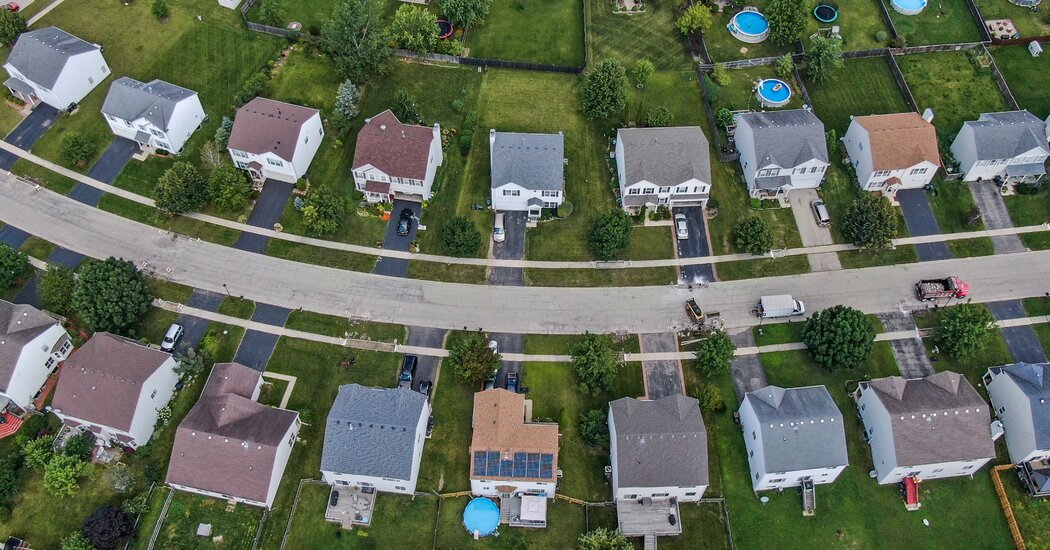With a new law, Illinois joins over a dozen states that have made it easier to remove racial restrictive covenants, which were used to bar people of certain races from buying homes.
A new law in Illinois allows homeowners to change their housing deeds to remove racist clauses that were used to bar people of certain races and religious groups from buying homes or living in a particular neighborhood.
The clauses, which are known as racial restrictive covenants, were outlawed under the Fair Housing Act in 1968, but they remain buried in an unknown number of property documents across the United States — relics of a broader effort by the real estate industry, federal housing authorities and individual homeowners to prevent integration.
In many states, it can be arduous, if not impossible, to remove the covenants from property records, prompting states such as Illinois to pass laws that streamline the process. As of Jan. 1, homeowners in the state can submit a request to their county recorder to remove the covenants. The cost per request is capped at $10.
Since 2018, at least 13 states have passed laws to make it easier to remove racial covenants from deeds. A bill to do so in New York is pending in the Legislature.
One of the first people to request the modification in Illinois was Nicole Sullivan, who has been trying to change her deed since around 2011, when she bought a house in Lake County, in the northeastern corner of the state.
Ms. Sullivan’s homeowner’s association had sent her a copy of the deed, dated March 1929, to explain why she could not create a fenced-off area for her dog on the property.
She was intrigued by the document, then alarmed when she found a clause stipulating that the house could never be sold to or occupied by “any person or persons of the African or Negro, Japanese, Chinese, Jewish or Hebrew races, or their descendants.”
Ms. Sullivan, who is white, and a neighbor tried to have the language removed but kept hitting roadblocks. Eventually, they approached State Representative Daniel Didech, a Democrat from Buffalo Grove, who with State Senator Adriane Johnson, also a Democrat from Buffalo Grove, sponsored legislation to allow changes in the Illinois General Assembly. Gov. J.B. Pritzker signed the bill into law in July.
Ms. Sullivan, 41, said that the law change was largely a symbolic victory and that there was much more to do to improve housing equity in her community and across the United States, but she hoped the law would help make her neighborhood more diverse.
“We’re stopping this cycle of recycling this language back into our community, so no longer will new community members interested in putting up a fence have to read about how their ancestors would not have been allowed to be there,” Ms. Sullivan said.
It is difficult to know how many property documents in the United States use racial covenants because they are in private agreements. There are local efforts underway in many cities and counties, including Cook County, to find and catalog these records.
A study by Lake Forest College in Lake Forest, Ill., found that by the late 1940s, more than 220 subdivisions in Cook County had created or adopted racial restrictive covenants.
“This subdivision is restricted to use by persons of the Caucasian race,” read an agreement recorded in September 1946. “This restriction shall not apply to domestic servants.”
Nobody had filed to modify their property record in Cook County as of Wednesday afternoon, Sally Daly, the deputy clerk of communications for the Cook County Clerk’s Office, said in an email.
Chloe Thurston, an assistant professor of political science at Northwestern University in Evanston, Ill., said the use of racial covenants expanded after a 1917 Supreme Court decision that made it illegal for cities to designate neighborhoods for specific racial groups, but they did not apply to private contracts.
Racial restrictive covenants were then used by realtors and federal housing authorities to prevent integration. In 1927, Nathan William MacChesney, a prominent lawyer, wrote a model racial restrictive covenant for the Chicago Real Estate Board that targeted only Black people. The Federal Housing Administration also recommended that racial restrictive covenants be included in homes that it insured.
In 1948, the Supreme Court made existing racial restrictive covenants unenforceable, but the ruling, Shelley v. Kraemer, did not entirely stop them from being used. Twenty years later, the Fair Housing Act made new covenants illegal.
Professor Thurston, who is the author of “At the Boundaries of Homeownership: Credit, Discrimination and the American State,” said it was worth asking whether the energy directed at changing laws to remove these unenforceable covenants came at the expense of tackling more urgent issues of housing equity.
Racial restrictive covenants, and other forms of housing discrimination such as redlining, shrank the housing supply for Black families and, as a result, their ability to pass down wealth to later generations, Professor Thurston said.
There is a longer legacy of other restrictive processes, she added, that is “not going to be addressed by simply removing language from a deed that most people don’t think about or see.”































